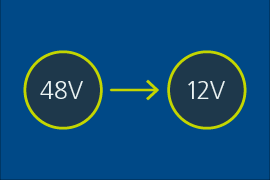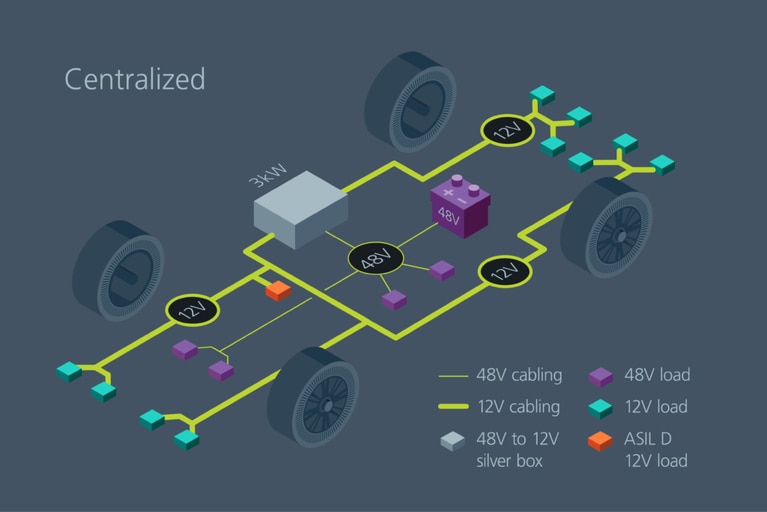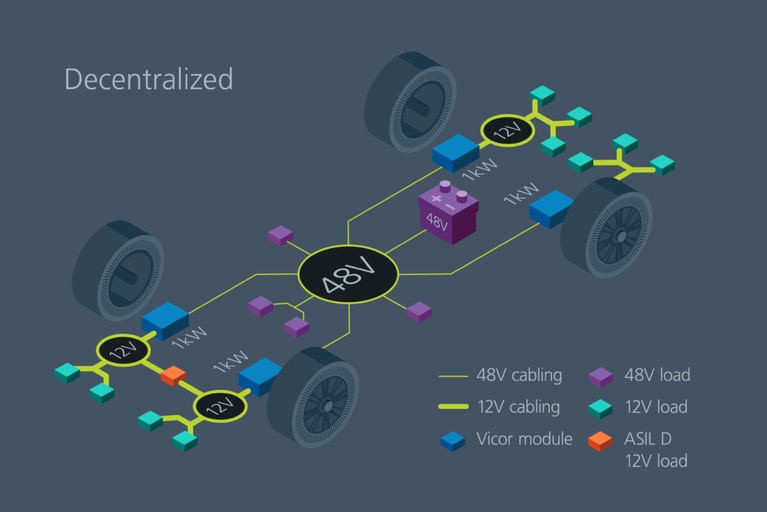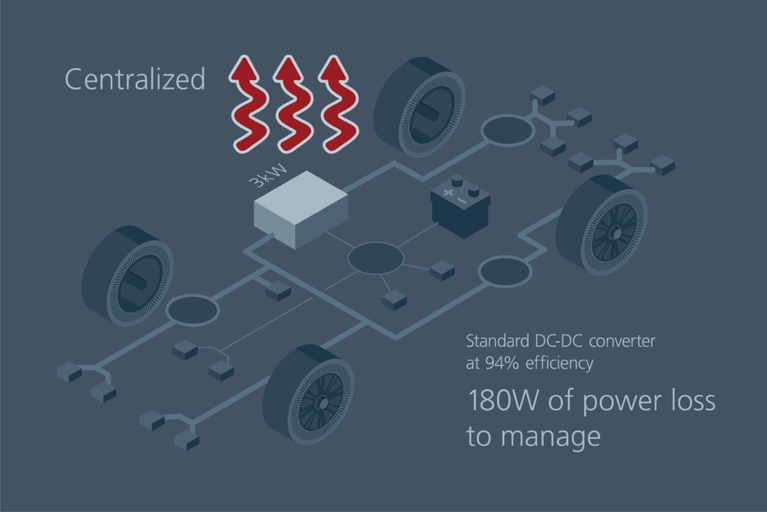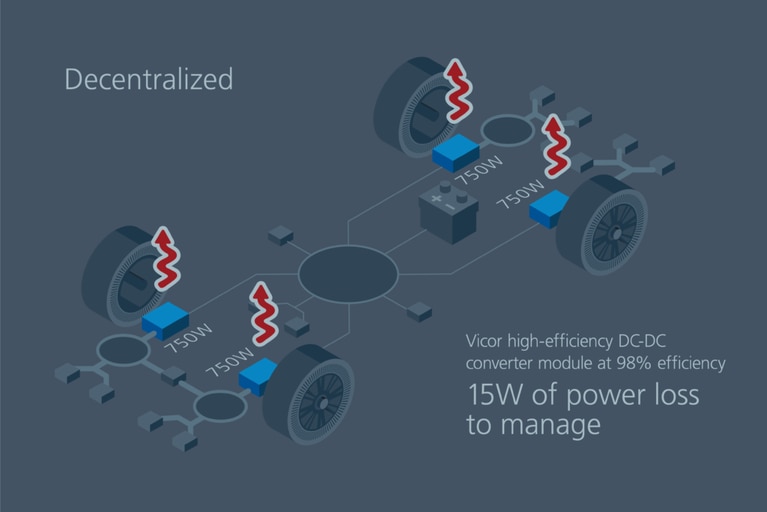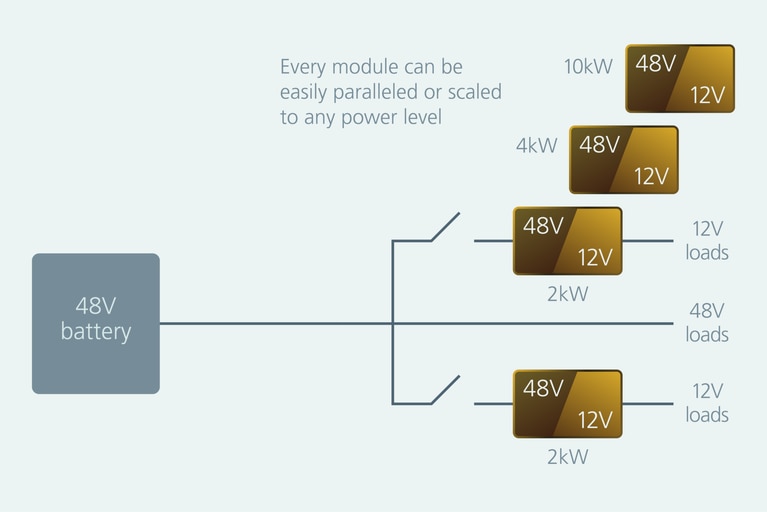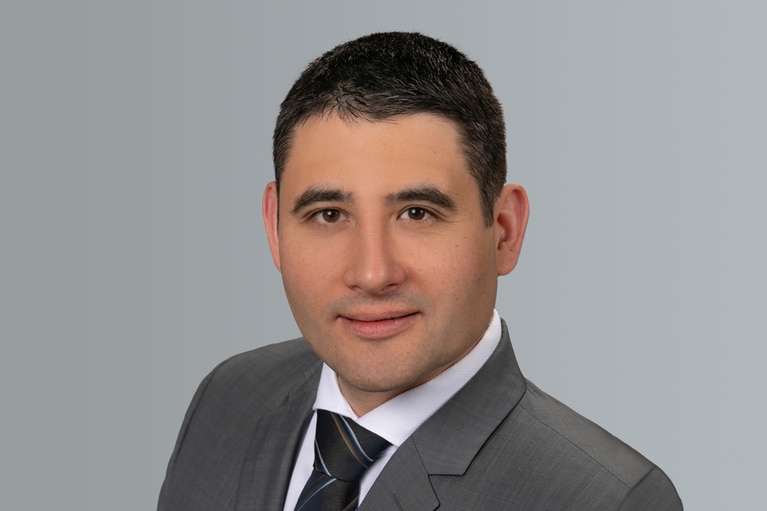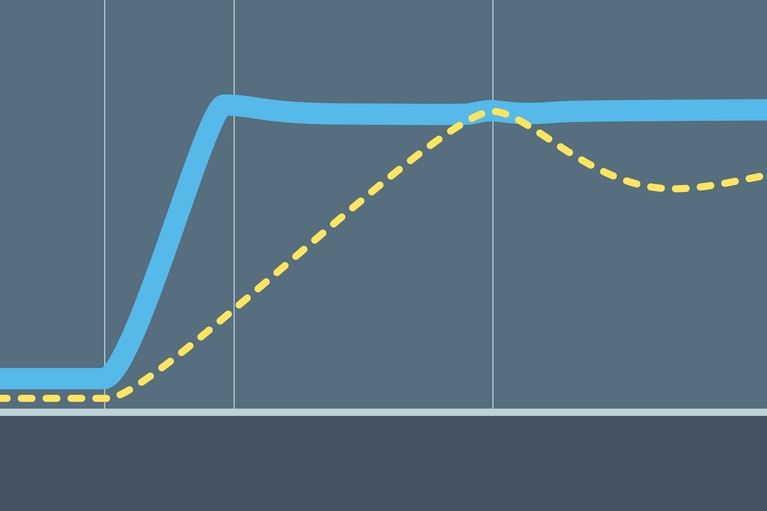
Bidirectional power and transient speed enable scalable active suspension
Sine Amplitude Converter™ modules offer a unique combination of bidirectionality and transient response to unlock new possibilities for active suspension
Tesla recently announced that 48V low-voltage systems will be used in all future electric vehicles. As the industry moves in this direction it poses an opportunity and a challenge for OEMs and Tier Ones to adapt. Adopting a zonal architecture that is decentralized, where 48V is being converted to 12V at the load, is the most efficient way to architect this type of system. Vicor small, power dense modules make it easy to design and build a zonal architecture to support xEVs.
Cars, trucks, buses and motorcycles makers are rapidly electrifying their vehicles to increase the fuel efficiency of internal combustion engines and reduce CO2 emissions. There are many electrification choices, but most opt for a 48V mild-hybrid system rather than a full-hybrid powertrain. In the mild-hybrid system, a 48V battery is added alongside the traditional 12V battery. This increases power capacity by 4 x (P = V • I), which can be used for heavier loads, such as the air conditioner and catalytic converter at start up. To increase vehicle performance, the 48V system can power a hybrid motor that is used for faster, smoother acceleration whilst saving on fuel. The additional power can also support steering, braking and suspension systems, plus new safety, entertainment and comfort features. A 48V mild-hybrid system provides a way to rapidly introduce new vehicles with lower emissions, longer range and higher gas mileage. It also delivers new and exciting design options for higher performance and features while still reducing CO2 emissions.
However, there’s a general hesitancy to modify the long-standing 12V power delivery network (PDN). Changes often require new technologies that need extensive testing and may require new suppliers that can deliver automotive industry’s high safety and quality standards.
Adding a 48V battery to power the heavier powertrain and chassis system loads provides options to engineers. Now there is a choice of adding systems that can deal directly with a 48V input, or to retain legacy 12V electromechanical loads such as pumps, fans and motors and instead convert the 48V to 12V via a regulated DC-DC converter. In order to manage change and risk, existing mild-hybrid power delivery systems are slowly adding 48V loads but still use a large centralized multi-kW 48V-to-12V converter that feeds 12V around the vehicle. However, this centralized architecture does not take the full advantage of a 48V PDN, nor does it utilize the benefits of available advanced converter topologies, control systems and packaging.
Figure 1: Traditional 12V centralized architecture.
Figure 2: 48V decentralized or zonal architecture.
The vast majority of these centralised DC-DC converters (Figure 1) are bulky and heavy, since they use older low-frequency PWM switching topologies. They also represent a single point of failure for many critical powertrain systems.
A different architecture to consider is decentralized power delivery (Figure 2) with modular power components. This power delivery architecture uses smaller, lower-power 48-to-12V converters, distributed throughout the vehicle close to the 12V loads. The simple power equations P = V • I and PLOSS = I2R explain why 48V is more efficient than distributing 12V.
For a given power level, the current is four times lower at 48V than in a 12V system and has 16 times lower losses ( I2R). At ¼ of the current, the cables and connectors can be smaller, lower weight and cheaper. The decentralised power architecture also has significant thermal management and power system redundancy benefits (Figure 4). It’s another way of spreading kilowatts of power around the vehicle without the weight, thermal concerns and volume of a traditional DC-DC converter.
Figure 3: Standard DC-DC converter is 94% efficient.
Figure 4: Vicor DC-DC converter is 98% efficient.
A modular approach to a decentralized power delivery (Figure 4) is highly scalable.
The 48V output from the battery is distributed to the various high-power loads in the vehicle, maximizing the benefits of lower current (4x) and lower losses (16x), resulting in a physically smaller and lower weight PDN. Depending on a load power analysis of the various distributed loads, one module can be designed and qualified for the right power granularity and scale the power level of the system upwards, when used in parallel arrays.
In this example, a 2kW module is shown. As noted, the granularity and scalability are system dependent. By using distributed modules instead of a large centralized DC-DC converter, N+1 redundancy is also possible at a much lower cost. This approach also advantageous when load power changes during the vehicle development phase. Instead of implementing changes to a full ground-up custom power supply, engineers can either add or eliminate modules. In addition, the module is already approved and qualified, reducing development time.
Figure 5: A modular approach to a fully electric vehicle.
In the case of pure electric vehicles or high-performance hybrid cars, high-voltage batteries are used due to the high power demands of the powertrain and chassis systems. A 48V SELV PDN still has significant benefits for OEMs, but now the power system designer has an additional challenge of a high-power 800V-to-48V or 400V-to-48V conversion.
This high-power DC-DC converter also requires isolation but not regulation. By using regulated PoL converters, the high-power upstream converter can use a fixed-ratio topology. This is extremely beneficial due to the wide input-to-output voltage range of 16:1 or 8:1 for 800/48 and 400/48, respectively; see Figure 5. Using a regulated converter over this range is very inefficient and presents a large thermal management problem. OEMs are often locating this efficient step down solution right inside the battery pack, and in some cases are able to eliminate the battery. Vicor’s fixed ratio high voltage conversion products deliver rapid current delivery at fast slew rates, enabling OEMs to lose the 12-14kg of unnecessary 48V battery weight.
It would be very difficult and costly to decentralize this high-voltage isolated converter due to safety requirements in distributing the 400V or 800V. However, a high-power centralized fixed-ratio converter can be designed utilizing power modules instead of a large silver box DC-DC converter.
Power modules of the right level of granularity and scalability can be developed and then easily paralleled for a range of vehicles with differing powertrain and chassis electrification requirements. Vicor BCM fixed-ratio bus converters are also bidirectional, which supports various energy regeneration schemes. Due to the sine amplitude converter (SAC) high-frequency soft-switching topology, BCMs achieve efficiencies over 98%. They also feature power densities of 2.6kW/in3, which significantly reduces the size of the centralized high-voltage converter.
Patrick Wadden joined Vicor in October 2018 as Global Vice President of Automotive Business Development to lead the company’s business in the Automotive Industry while becoming a key partner to companies developing mild hybrid, EV/HEV and autonomous vehicles.
By Patrick Wadden, Global Vice President of Automotive Business Development
Prior joining Vicor, Nicolas worked at IDT (Renesas) as the North America Automotive Segment leader focused on technical sales in powertrain, infotainment and ADAS based systems. Prior to IDT, he spent four years at ON Semiconductor in the role of Field Application Engineer leading an internal design and applications team as a “Concept to Product Champion” heading up the company’s new product growth strategy for automotive sales in Detroit, MI. His background also includes nine years of engineering and development at Continental Automotive where he held various engineering roles in their hybrid and electric vehicle divisions designing DC-DC converters and traction inverters.
Nicolas Richard, Director Automotive Business Development, Vicor Europe
This article was originally published by Electronics World.
Bidirectional power and transient speed enable scalable active suspension
Sine Amplitude Converter™ modules offer a unique combination of bidirectionality and transient response to unlock new possibilities for active suspension
Delivering improved peak power and dynamic transient response to unlock lighter, more powerful EV architectures
With each passing year, electric vehicles (EVs) on the market are becoming increasingly reliant such as steer-by-wire, brake-by-wire and active suspension.
Accelerate your move to a high performance 48V power delivery network
This eBook provides guidance on designing 48V power delivery networks to enhance the performance, efficiency, and reliability of industrial products
Innovating power delivery networks
Vicor is innovating with power delivery networks. Improving end-system performance requires innovative power technologies
